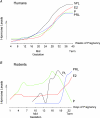The role of oestrogens in the adaptation of islets to insulin resistance
- PMID: 19687125
- PMCID: PMC2790246
- DOI: 10.1113/jphysiol.2009.177188
The role of oestrogens in the adaptation of islets to insulin resistance
Abstract
Pregnancy is characterized by peripheral insulin resistance, which is developed in parallel with a plasma increase of maternal hormones; these include prolactin, placental lactogens, progesterone and oestradiol among others. Maternal insulin resistance is counteracted by the adaptation of the islets of Langerhans to the higher insulin demand. If this adjustment is not produced, gestational diabetes may be developed. The adaptation process of islets is characterized by an increase of insulin biosynthesis, an enhanced glucose-stimulated insulin secretion (GSIS) and an increase of beta-cell mass. It is not completely understood why, in some individuals, beta-cell mass and function fail to adapt to the metabolic demands of pregnancy, yet a disruption of the beta-cell response to maternal hormones may play a key part. The role of the maternal hormone 17beta-oestradiol (E2) in this adaptation process has been largely unknown. However, in recent years, it has been demonstrated that E2 acts directly on beta-cells to increase insulin biosynthesis and to enhance GSIS through different molecular mechanisms. E2 does not increase beta-cell proliferation but it is involved in beta-cell survival. Classical oestrogen receptors ERalpha and ERbeta, as well as the G protein-coupled oestrogen receptor (GPER) seem to be involved in these adaptation changes. In addition, as the main production of E2 in post-menopausal women comes from the adipose tissue, E2 may act as a messenger between adipocytes and islets in obesity.
Figures


References
-
- Ackermann S, Hiller S, Osswald H, Losle M, Grenz A, Hambrock A. 17β–Estradiol modulates apoptosis in pancreatic β–cells by specific involvement of the sulfonylurea receptor (SUR) isoform SUR1. J Biol Chem. 2009;284:4905–4913. - PubMed
-
- Adachi T, Yasuda K, Mori C, Yoshinaga M, Aoki N, Tsujimoto G, Tsuda K. Promoting insulin secretion in pancreatic islets by means of bisphenol A and nonylphenol via intracellular estrogen receptors. Food Chem Toxicol. 2005;43:713–719. - PubMed
-
- Alonso A, Ordóñez P, Fernández R, Moreno M, Llaneza P, Patterson AM, González C. 17β–Estradiol treatment is unable to reproduce p85α redistribution associated with gestational insulin resistance in rats. J Steroid Biochem Mol Biol. 2009;116:160–170. - PubMed
Publication types
MeSH terms
Substances
LinkOut - more resources
Full Text Sources
Medical

